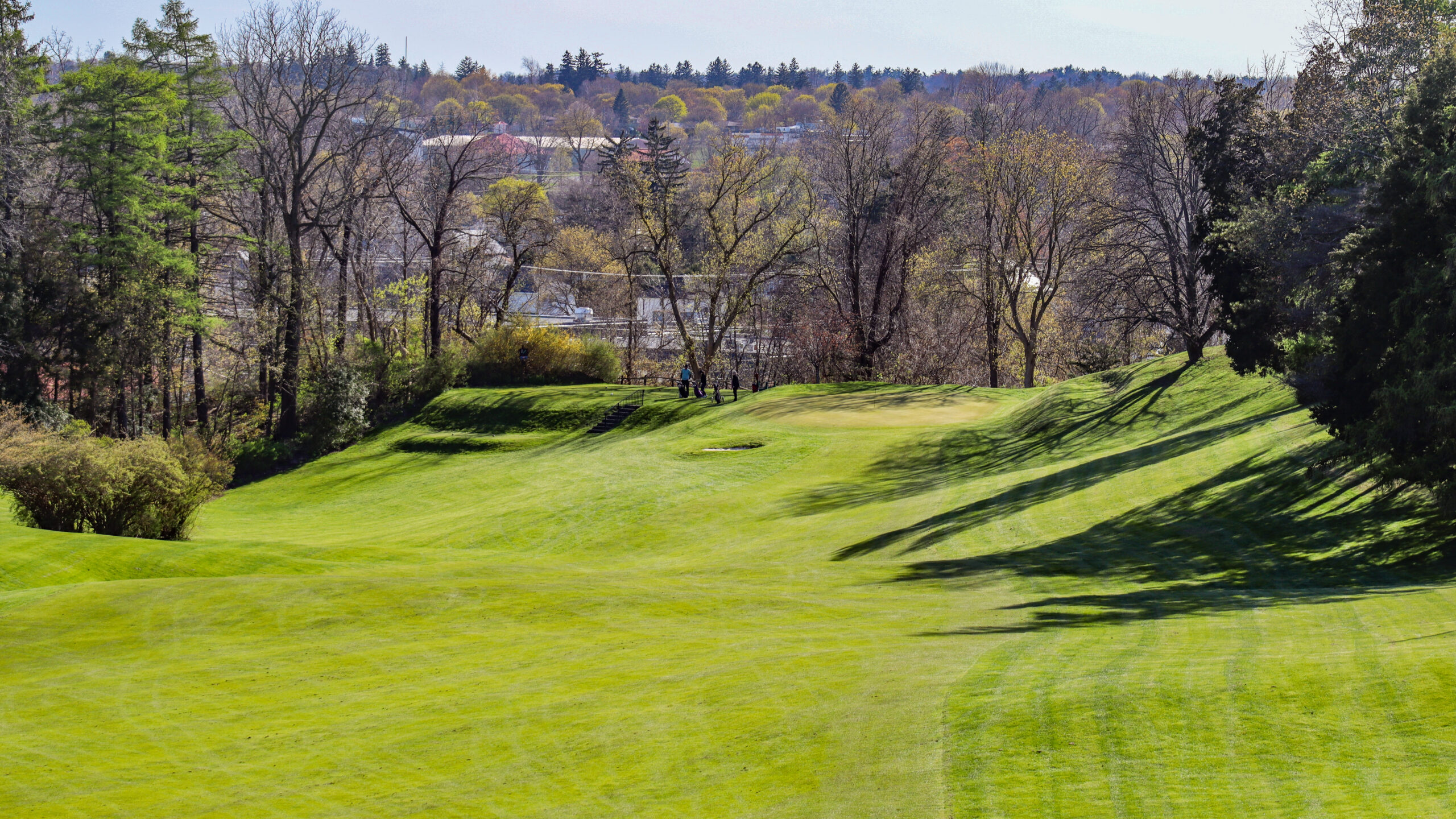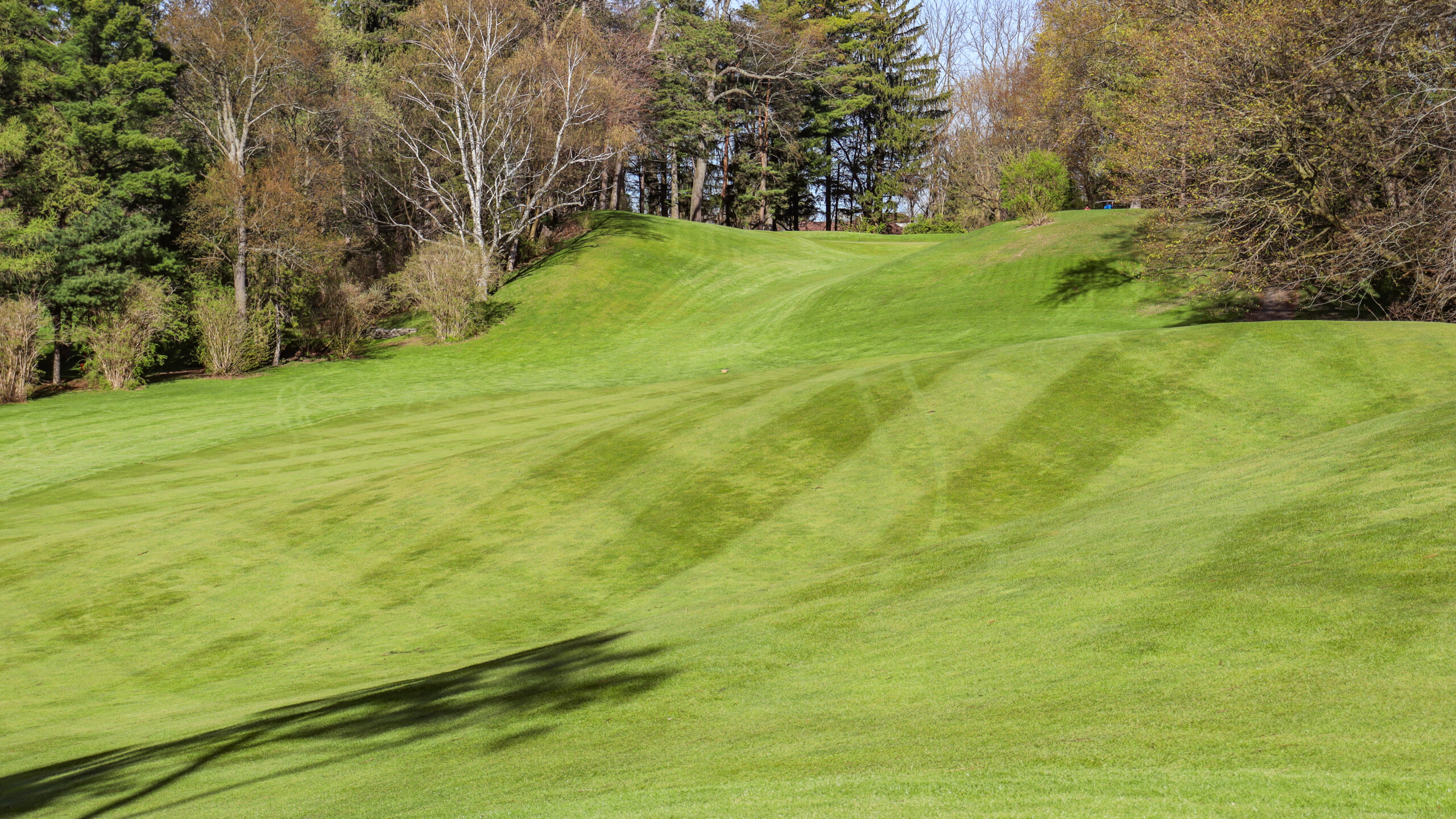I’ll admit, here and now, that upon arrival at Norfolk I harboured a bit of a skeptical and chap fallen attitude, engendered by the endless procession of dead-flat farm-fields that smother the anonymous two-lane roads leading to and from Simcoe, in combination with the windswept, thirty-five plus degree, five-hour round I’d trudged through that morning at the relatively nearby Tarandowah, a slog of a golf course from its par 70, 7100 yard tips (one of the very few golf courses that SCOREGolf has ranked more accurately than we do, in my view—75th according to them, and 58th according to us)
Here’s a place where Ernie and Ted and Maurice and Bruce can enjoy endless Labatt Blues and play gin-rummy while recounting, for the 984th time, how Ernie’s father, Harold, a member of the 1st parachute battalion, reportedly held off an entire platoon of Germans single-handedly during the battle of the bulge with merely a pistol and despite taking a bayonet in the groin, the clubhouse screams.
Moreover, Norfolk isn’t ranked on any top 100 list, and, in truth, I struggle to truly enjoy anything outside of, say, the top 60 or so in Canada. So suffice to say, despite being thrilled to get to play with co-author Jason again, I wasn’t in the best mindset turning into the property.

First impressions are hard to shake, and Norfolk certainly makes a strong one, an impression that, by the time I re-tied my Footjoys, got me in the mood again to smack the ball around the yard. To the left of the entrance drive, a view of the insanely tumbling, roller-coaster par 5, 5th, is afforded, with its slender green set beyond a thirty-foot roll in the fairway and tucked at an almost 45 angle to the playing corridor. Then you get a glimpse of the uphill par 3, 6th, which, from the car, I initially believed was a short par 4, considering how small the green is and how severely it is perched—no chance I’m hitting a long iron to that, I told myself (how wrong I was—and you better hit it, or else….). Finally, you arrive at the parking-lot which is located literally in the shadow of the perfectly rectangle, brown-hardwood and grey-cinder clubhouse that is cut into a sharp ridge atop which the 1st and 7th tee and detached pro-shop cum bag-shop are set. In essence, if I was asked to draw the most stereotypical 1950s Legion or Curling Club, it would probably look a lot like Norfolk’s rustic, though strangely charming and comforting clubhouse.

Norfolk’s wonderful opener, a taste of things to come
Here’s a place where Ernie and Ted and Maurice and Bruce can enjoy endless Labatt Blues and play gin-rummy while recounting, for the 984th time, how Ernie’s father, Harold, a member of the 1st parachute battalion, reportedly held off an entire platoon of Germans single-handedly during the battle of the bulge with merely a pistol and despite taking a bayonet in the groin, the clubhouse screams. Its musty odor. The uniform rows of metallic and slightly rusted and dented high-school lockers, half of which are now vacant, lining the nude cinder-block walls of the men’s changing room. The cracked and crooked and dust-layered frames bearing black-and-white photographs and newspaper clippings announcing exploits and happenings now a half-century vintage. The green, badly footstep-worn carpet. The beige vinyl couch bearing innumerable wrinkles and creases and suspect stains. The old Panasonic TV and transistor radio, antennas erect. The couple punctured black, white, and green dartboards set against brown-cork backdrops. The ghostly and humid squash courts, still bearing skid marks on their floors and walls, which haven’t seen action in years. I fancy places like this, harbingers to Canadiana of more glorious yesteryears.
Jason, whose knowledge of the golf course and its history is most impressive considering his short-time as a member, remarked that Norfolk was once-upon-a-time a routine hangout for the who’s-who of southern-Ontario golf circles, quite the “player’s club”, as evidenced by the pictures of the Thompson Brothers and other notables figures that are hung in the main dining room (which, unfortunately, was locked by the time of evening when we played). In fact, a local train line once ran just south of the property, which allowed golfers from all over the region to easily get to the club, including those from Brantford, with whom Norfolk held an interclub-match for many decades.
The exact extent to which the Toronto Terror was involved in the design of the golf course is unclear; however, as Jason remarked, considering the significant amount he spent at the club, chances are that he advised modifications, here and there, likely pro-bono. There’s a distinct Thompson-flavor to a number of the green-sites, in particular the 2nd, 3rd, 4th, and 7th. Sleuth Jason, ever curious, is on the case, worry not.
In truth, it’s easy to see why so many great players hung-out here upon playing the golf course, which, despite being short by modern standards, is no push-over. Routinely you must shape shots, hit from insanely canted lies, and a miss is often severely, though not unplayably, punished. With equipment from the first half of the 20th century, Norfolk must’ve been an absolute beast to play, hence its high reputation during its halcyon days.
Yet, at the same time, as with the best golf courses, there are no shots beyond the faculties of a beginner or junior or less-skilled golfer. And although the golf course could use some tree-removal, quite a bit of it in fact, the plantings are usually sparse and clean beneath, meaning that balls lost should be kept to a minimum. Moreover, the routing allows for a variety of different combinations to be played, with the 1st, 7th, 9th all starting from near the clubhouse, and the 5th and 8th playing from essentially the same starting point.
- The insanely canted fairway and perched green site on the par 4, 3rd
- The tee shot on the incredible par 5, 5th
Of its nine holes, 2 are genuinely all-Canadian level (the 3rd and the 5th), 4 are solid (the 1st, 2nd, 6th, and 8th), and 3 are fine, if slightly pedestrian (the 4th, 7th, and 9th). All in all, pretty darn good, I’d say.
For a city of Norfolk’s size and location, this is a perfect option for locals, especially juniors. The price is right, and Jason tells me that the tee-sheet is usually pretty sparse, meaning that you can pop-in for a quick round essentially whenever you fancy. Most importantly, this is a place where, on school-free summer days, parents can drop their kids off in the morning and then pick them up again in the afternoon, the way I learned to play at my local club, the way the game is best ingratiated, and the way one’s youth is best wasted, in my view.
Would I go an hour and a half out of my way to see it, specifically? Debatable. I’ve certainly gone further for far worse, let me tell you. But I’m sure glad I made the detour and took the time to see it, and I’d strongly recommend anyone who finds themselves in the area to do so, too. An evening at Norfolk comes highly recommended from me.




